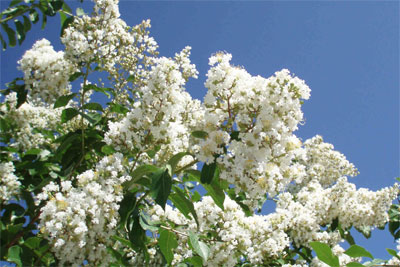Texas Tree Tips – September, 2012

Pruning crape myrtles correctly brings out the best in this favorite landscape tree. Photos by Bill Seaman.
Crape Myrtle Pruning
In order to properly prune any tree, a basic understanding of the characteristics and growth habit of the tree is a must. A crape myrtle is not quite like any other plant in how it grows and, therefore, is not like others when considering how it should be pruned. Crape myrtles are a diverse group of ornamental plants that bloom profusely throughout most of the growing season. Size will be a factor in pruning, since some crape myrtle varieties can grow to a height exceeding 25 feet.
As a group, crape myrtles are very hard-wooded. Their small twigs and old seedpods do not produce new growth in the spring. Tip growth normally dies back 7 to 12 inches in the winter months. If a crape myrtle is not tip-pruned by spring, the new growth will emerge just below the margin of the dead twig tissue. Since crape myrtles are rapid growers, the new growth quickly obscures the view of the dead tips, usually within a few weeks. The twiggy tips and seedpods are of no consequence to the overall health of the plant. Aesthetically, it is for only the first few weeks of the growing season that the dead tips are not attractive.

Basal sprouts are common to some varieties of crape myrtles. They can be managed with periodic pruning.
Some crape myrtle varieties are also known for producing sprouts that grow from roots near the root collar. These sprouts are typically removed in favor of larger existing trunks. In the case of larger-growing varieties, it is best to remove any excessive amount of root sprouts to improve the health of a few remaining trunks.
The four factors that should be considered in the pruning of crape myrtles are health, structural integrity, aesthetics, and the cost or time to maintain the desired condition. Crape myrtles are hardy plants that can survive moderate freeze damage and severe reductions in size — even cutting to ground level. Those that are planted where winter temperatures drop below zero may respond like woody perennials and sprout back from their roots.
From a pure health perspective, crape myrtles should be pruned in the same fashion as shade trees, by removing crossing limbs and canes, root sprouts, and dead wood. This type of pruning can be done any time of the year and is the most beneficial to the long-term health, structural integrity, and longevity of the plant.

Removing seedpods can improve a crape myrtle’s overall aesthetic, but the effort is labor-intensive and does not improve the general health of the tree.
Tip pruning of crape myrtles, when done correctly, can make them more attractive. However, as the tree becomes larger, tip pruning becomes labor intensive. Proper tip pruning should be done in late January through March, but not after the new leaf buds have emerged in the spring. Current research shows that heavy pruning at other times of the year may increase the likelihood of freeze damage. Tip pruning should be done only to pencil-sized twigs — no larger, and in a form consistent with the plant’s natural growth habit.

Crape myrtles should never be topped. The practice destroys the natural shape of the plants and negatively impacts their health. Photo by Neil Sperry.
The top growth should not be cut flat. If the goal of pruning is to restrict the crape myrtle’s height, replace it with a variety that is more size appropriate. With all the crape myrtle varieties now available to gardeners, be cautious not to plant one that will grow too large for its surroundings. Crape myrtles should never be topped. In addition to destroying the plant’s natural form, severe pruning reduces food storage, fosters poor branching habit, and negatively affects a crape myrtle’s general health. Though George Washington once admitted to removing a family cherry tree with the famous words “I cannot tell a lie,” he swore he had nothing to do with the topping of the crape myrtles!
Since all crape myrtles will have dead tips in the spring, removal of pencil-sized twigs avoids viewing the dead portion and is more aesthetically pleasing to some owners. The amount of time required to achieve that positive effect is much less for small- or medium-sized crape myrtles — as opposed to larger trees. Large varieties can be structurally pruned as noted above; however, tip pruning can be very time-consuming and is not of much benefit to the tree’s overall health. The best show of flowers can be obtained by constantly removing the spent seedpods (deadheading) throughout the growing season, although that, too, can be very time-consuming.
In summary, if you are concerned only about health and structural integrity, prune your crape myrtle like a small shade tree. If you are concerned with the aesthetics, prune it like a small shade tree and also tip prune. If you really want show, prune the seedpods as they die. Each additional step involves more time and cost. What is right for you depends on your personal preference, the characteristics of the plant, the site and of course … your budget.
About the author: Steve Houser is a Dallas native with more than 30 years of experience as a consulting arborist and tree climber. He is the president of Arborilogical Services Inc., “The Experts Your Trees Deserve.” www.arborilogical.com.
